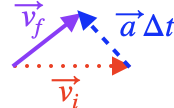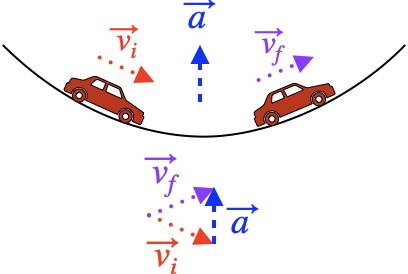Vector Acceleration
Just as velocity is the change in position over a given time interval, acceleration is the change in velocity over a given time interval:In other words, $\vec a_{avg}\Delta t=\Delta \vec v$, or $$\vec v_f=\vec v_i+\vec a_{avg}\Delta t$$
The vector $\vec a_{avg}\Delta t$ (which points in the same direction as the acceleration $\vec a_{avg}$) is the vector you have to add to the initial velocity in order to get the final velocity. We talked a little bit about the direction of acceleration in Acceleration; here we can demonstrate why it works the way it does:
Column

If the acceleration points in the same-ish direction as the velocity, then the object will speed up: notice how $\vec v_f$ is longer than $\vec v_i$.
Column

If the acceleration points in the opposite-ish direction as the velocity, then the object will slow down: notice how $\vec v_f$ is shorter than $\vec v_i$.

For example, suppose a car is going through a dip. Before the bottom, the car is moving downward, but after the bottom the car is moving upward. The acceleration of the car must point upwards, because you have to cancel out the "down" and replace it with "up".